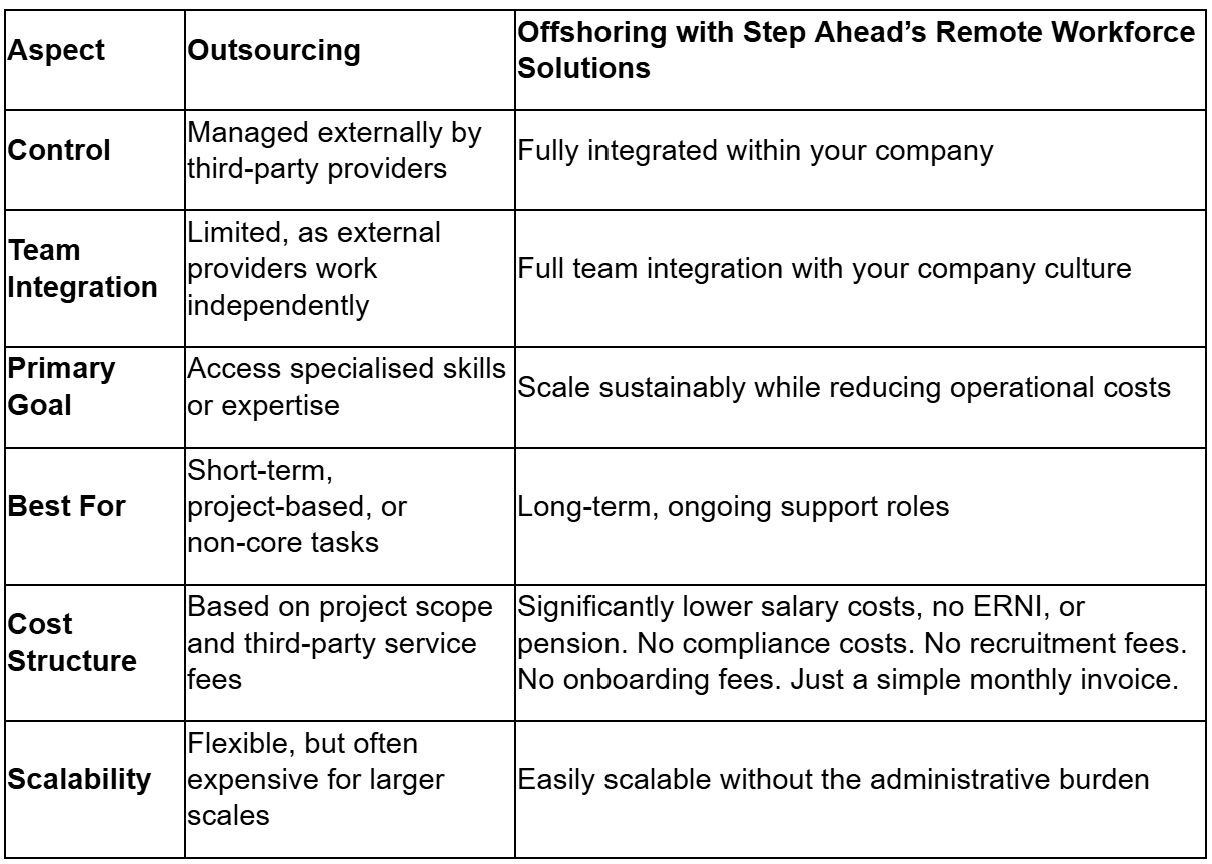Insights
Outsourcing vs. Offshoring: Choosing the Right Path with Step Ahead’s Remote Workforce Solutions
For nearly 30 years, Step Ahead has been helping UK businesses source high-quality talent and navigate an ever-evolving employment landscape. With the launch of our Remote Workforce Solutions, we’re offering a fresh, streamlined approach to remote hiring—one designed to save you time, money, and effort.
Nov 9, 2024
As businesses face rising costs and increased complexity, we're often asked: Is offshoring the best option, or would outsourcing be more beneficial? This blog will break down the key differences between outsourcing and offshoring and highlight how each approach can serve your business. To dive deeper into effective offshoring practices, see our Guide to Achieving Success in Offshoring. IF you're looking for an overview of how recent legislation affects hiring in the UK, read more in our blog on the Employment Rights Bill 2024.
Understanding the Basics: What is Outsourcing?
Outsourcing involves contracting specific tasks or functions to an external company. This approach is often used for non-core business functions, such as IT support, customer service, or marketing, where external specialists can handle tasks more efficiently or cost-effectively.
Key Features of Outsourcing:
Third-Party Providers: Outsourced tasks are managed by an external provider.
Specialised Expertise: Often utilised for tasks requiring specific skills.
Flexible Contracts: Can be used for short-term or project-based work.
Cost-Efficiency: Reduces overhead by allowing businesses to focus on core competencies.
Example: A UK-based business may outsource its digital marketing to a specialised agency rather than hiring an in-house team.
How Offshoring is Different
Offshoring, on the other hand, involves moving certain roles or functions to another country where operating costs are lower, with the team members working directly for your company. This model is ideal for businesses looking to build a long-term team that integrates fully into their operations.
Key Features of Offshoring:
Direct Integration: Offshored employees work directly for your business, following your processes and values.
Access to Global Talent: Allows companies to tap into a broader talent pool.
Cost Reduction: Savings from lower operational costs, especially for roles that don’t require a physical presence.
Long-Term Scalability: Suitable for ongoing, integral business functions rather than project-based work.
Example: A UK-based company hires a team of remote customer service representatives in India to handle customer support, integrating them fully into the company’s existing processes.
Outsourcing vs Offshoring: Key Differences
To give a clear picture, here’s a side-by-side comparison of how outsourcing and offshoring differ:

Benefits and Challenges of Each Approach
Outsourcing Benefits:
Access to specific expertise without in-house hiring.
Flexible, short-term contracts available.
Reduced administrative burden.
Outsourcing Challenges:
Less control over operations and processes.
Potential for communication gaps with external providers.
Less cultural alignment and potential quality concerns.
Offshoring Benefits:
Cost savings, especially in regions with lower wage costs.
Direct control and alignment with your company’s goals.
Builds long-term, consistent support teams.
Offshoring Challenges:
Requires an investment in onboarding and training.
Potential communication challenges across time zones.
Requires compliance with local labour laws.
To understand how recent UK legislation impacts these costs, check out our article on the Employment Rights Bill 2024.
Why Step Ahead’s Remote Workforce Solutions is a Game-Changer
With rising UK employment costs and regulatory changes, many businesses are feeling the strain. Step Ahead’s Remote Workforce Solutions is designed to help companies overcome these challenges by offering a high-quality, fully integrated offshore team solution. Here’s why our model stands out:
Huge Cost Savings: By leveraging purchasing power parity, businesses enjoy lower wage costs without the added burden of ERNI, pension contributions, or other UK employment law expenses.
Seamless Integration: Unlike typical offshoring models, our team becomes an extension of yours. We manage all aspects of sourcing, compliance, and payroll, and ensure that our vetted professionals align with your company culture.
Scalable and Flexible: Need to grow your team quickly? Our model supports scalable team expansion without the overhead of traditional recruitment processes.
Our approach takes the guesswork out of offshoring, giving businesses a reliable, effective way to expand their teams without compromising on quality or integration.
Conclusion
Both outsourcing and offshoring offer unique advantages, but for companies seeking long-term, fully integrated support, offshoring may provide a more sustainable solution. Step Ahead’s Remote Workforce Solutions is designed to maximise these benefits, creating cohesive, high-performing teams at a fraction of the cost of traditional hiring.
To learn more about how offshoring can work for your business, visit our full guide on Achieving Success in Offshoring. If you're interested in understanding the broader impact of the Employment Rights Bill on staffing costs, book a call with one of our consultants HERE.


